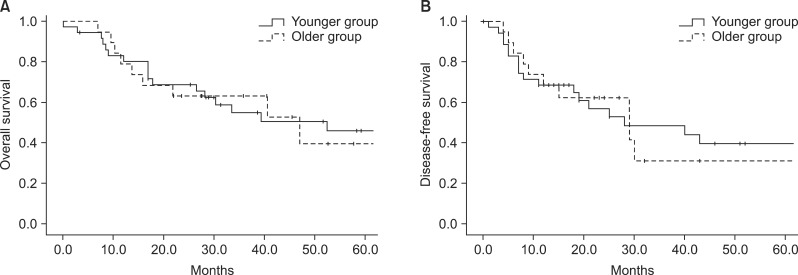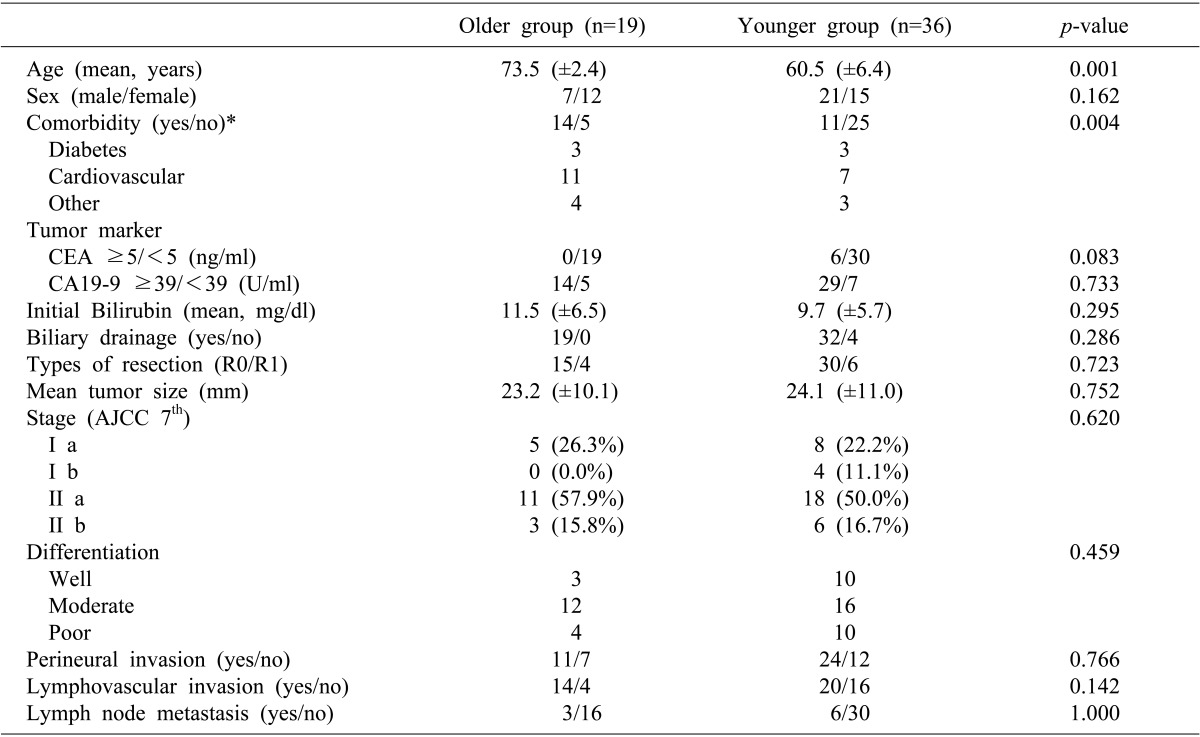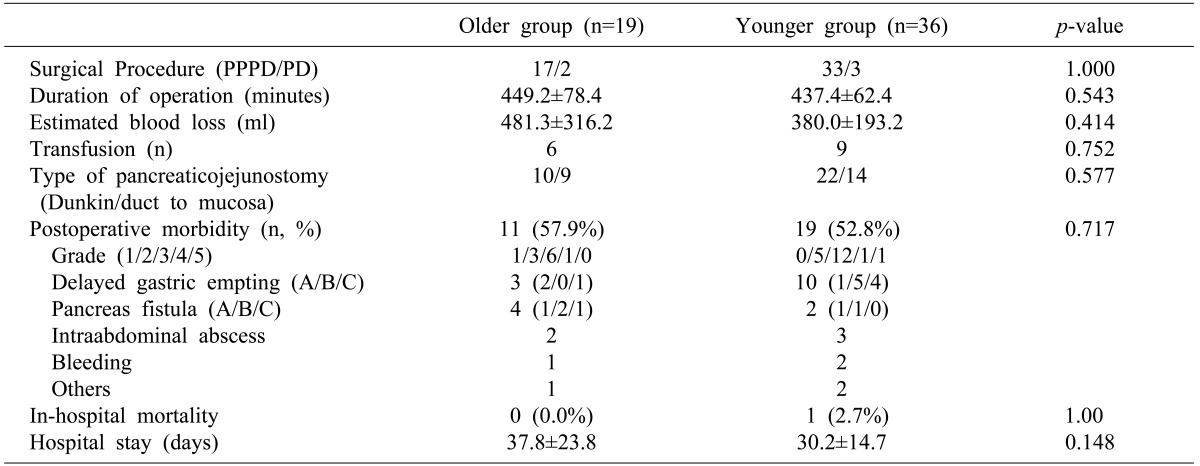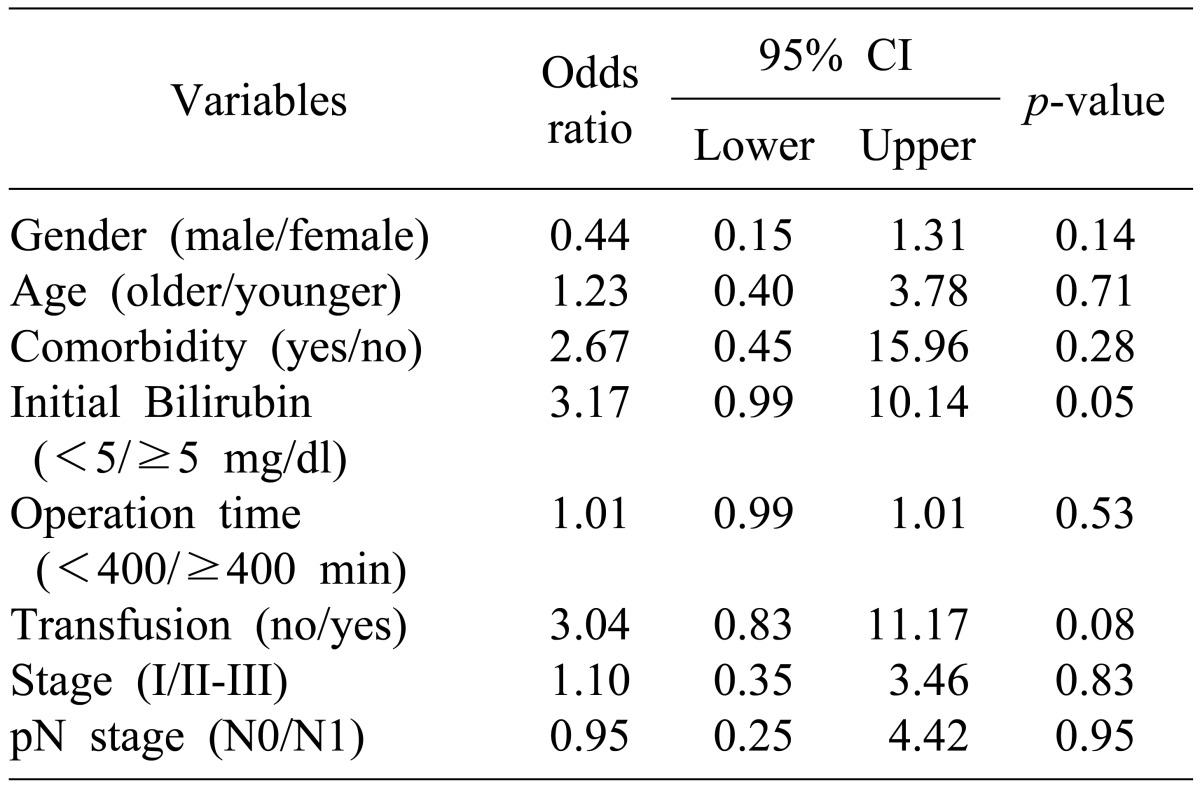1. Takenaka K, Shimada M, Higashi H, et al. Liver resection for hepatocellular carcinoma in the elderly. Arch Surg. 1994; 129:846–850. PMID:
8048856.

2. Nomura F, Ohnishi K, Honda M, Satomura Y, Nakai T, Okuda K. Clinical features of hepatocellular carcinoma in the elderly: a study of 91 patients older than 70 years. Br J Cancer. 1994; 70:690–693. PMID:
7917919.

3. Nagasue N, Chang YC, Takemoto Y, Taniura H, Kohno H, Nakamura T. Liver resection in the aged (seventy years or older) with hepatocellular carcinoma. Surgery. 1993; 113:148–154. PMID:
8381563.
4. Thomas DR, Ritchie CS. Preoperative assessment of older adults. J Am Geriatr Soc. 1995; 43:811–821. PMID:
7602039.

5. Yasuda K, Shiraishi N, Adachi Y, Inomata M, Sato K, Kitano S. Risk factors for complications following resection of large gastric cancer. Br J Surg. 2001; 88:873–877. PMID:
11412261.

6. Hodul P, Tansey J, Golts E, Oh D, Pickleman J, Aranha GV. Age is not a contraindication to pancreaticoduodenectomy. Am Surg. 2001; 67:270–275. PMID:
11270888.

7. Yeo CJ, Cameron JL, Sohn TA, et al. Six hundred fifty consecutive pancreaticoduodenectomies in the 1990s: pathology, complications, and outcomes. Ann Surg. 1997; 226:248–257. PMID:
9339931.
8. Bentrem DJ, Yeh JJ, Brennan MF, et al. Predictors of intensive care unit admission and related outcome for patients after pancreaticoduodenectomy. J Gastrointest Surg. 2005; 9:1307–1312. PMID:
16332487.

9. Fong Y, Gonen M, Rubin D, Radzyner M, Brennan MF. Long-term survival is superior after resection for cancer in high-volume centers. Ann Surg. 2005; 242:540–544. PMID:
16192814.

10. Ho V, Heslin MJ. Effect of hospital volume and experience on in-hospital mortality for pancreaticoduodenectomy. Ann Surg. 2003; 237:509–514. PMID:
12677147.

11. Sosa JA, Bowman HM, Gordon TA, et al. Importance of hospital volume in the overall management of pancreatic cancer. Ann Surg. 1998; 228:429–438. PMID:
9742926.

12. Gouma DJ, van Geenen RC, van Gulik TM, et al. Rates of complications and death after pancreaticoduodenectomy: risk factors and the impact of hospital volume. Ann Surg. 2000; 232:786–795. PMID:
11088073.

13. Jarnagin WR, Shoup M. Surgical management of cholangiocarcinoma. Semin Liver Dis. 2004; 24:189–199. PMID:
15192791.

14. DeOliveira ML, Cunningham SC, Cameron JL, et al. Cholangiocarcinoma: thirty-one-year experience with 564 patients at a single institution. Ann Surg. 2007; 245:755–762. PMID:
17457168.
15. Nagorney DM, Donohue JH, Farnell MB, Schleck CD, Ilstrup DM. Outcomes after curative resections of cholangiocarcinoma. Arch Surg. 1993; 128:871–877. PMID:
8393652.

16. Park JH, Choi YI, Kim YH, Kang KJ, Lim TJ. The complication rate according to the method of pancreaticojejunostomy after pancreaticoduodenectomy. Korean J Hepatobiliary Pancreat Surg. 2009; 13:42–48.
17. Dindo D, Demartines N, Clavien PA. Classification of surgical complications: a new proposal with evaluation in a cohort of 6336 patients and results of a survey. Ann Surg. 2004; 240:205–213. PMID:
15273542.
18. Pratt WB, Maithel SK, Vanounou T, Huang ZS, Callery MP, Vollmer CM Jr. Clinical and economic validation of the International Study Group of Pancreatic Fistula (ISGPF) classification scheme. Ann Surg. 2007; 245:443–451. PMID:
17435552.

19. Wente MN, Bassi C, Dervenis C, et al. Delayed gastric emptying (DGE) after pancreatic surgery: a suggested definition by the International Study Group of Pancreatic Surgery (ISGPS). Surgery. 2007; 142:761–768. PMID:
17981197.

21. Damhuis RA, Tilanus HW. The influence of age on resection rates and postoperative mortality in 2773 patients with gastric cancer. Eur J Cancer. 1995; 31A:928–931. PMID:
7646924.

22. Alves A, Panis Y, Mathieu P, Mantion G, Kwiatkowski F, Slim K. Association Française de Chirurgie. Postoperative mortality and morbidity in French patients undergoing colorectal surgery: results of a prospective multicenter study. Arch Surg. 2005; 140:278–283. PMID:
15781793.
23. Katai H, Sasako M, Sano T, Fukagawa T. Gastric cancer surgery in the elderly without operative mortality. Surg Oncol. 2004; 13:235–238. PMID:
15615661.

24. Gretschel S, Estevez-Schwarz L, Hünerbein M, Schneider U, Schlag PM. Gastric cancer surgery in elderly patients. World J Surg. 2006; 30:1468–1474. PMID:
16850149.

25. Bittner R, Butters M, Ulrich M, Uppenbrink S, Beger HG. Total gastrectomy. Updated operative mortality and long-term survival with particular reference to patients older than 70 years of age. Ann Surg. 1996; 224:37–42. PMID:
8678615.
26. Habu H, Endo M. Gastric cancer in elderly patients--results of surgical treatment. Hepatogastroenterology. 1989; 36:71–74. PMID:
2731911.
27. Balachandran P, Sikora SS, Raghavendra Rao RV, Kumar A, Saxena R, Kapoor VK. Haemorrhagic complications of pancreaticoduodenectomy. ANZ J Surg. 2004; 74:945–950. PMID:
15550080.

28. Richter A, Niedergethmann M, Lorenz D, Sturm JW, Trede M, Post S. Resection for cancers of the pancreatic head in patients aged 70 years or over. Eur J Surg. 2002; 168:339–344. PMID:
12428871.






 PDF
PDF ePub
ePub Citation
Citation Print
Print





 XML Download
XML Download